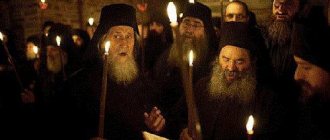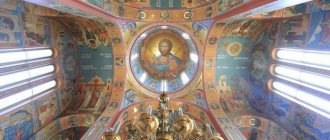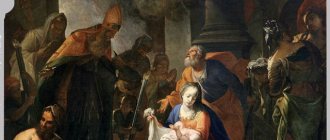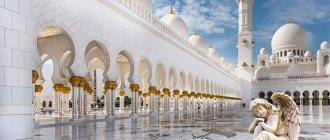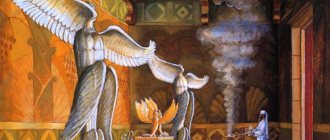Omophorion is a Greek word meaning “carried on the shoulders.” Other names: amice (ramen - shoulders), maforium. In ancient times, an omophorion was a large scarf that fell over the shoulders, and it was part of women's clothing. Now the omophorion is part of the liturgical vestments of the bishop.
There are two types of omophorion:
- great omophorion - a ribbon about one and a half meters long (depending on size), quite wide. They are put on, going around the neck, one end is brought behind the back, the other lies on the chest, the ends reach almost to the hem of the sakkos;
- small omophorion - both ends of the ribbon are fastened on the chest.
The omophorion is sewn from the same fabric as the sakkos and decorated with images of crosses.
The decoration of the omophorion is similar to the decoration of the deacon's orarion: stripes of another fabric are sewn along the long sides, and two parallel strips across at both ends.
Spiritual meaning
The meaning of the omophorion is explained by Saint Simeon, Archbishop of Thessalonica: “Omophorion means the incarnation of man for our sake and the incarnation of the Word that was from the Virgin.” The omophorion symbolizes the lost sheep, which the Lord took on his shoulders - that is, our human nature, came down from heaven, became incarnate and, called the lamb, was sacrificed for our sins.
The omophorion reminds us that the bishop is the image of Jesus Christ, and has the same care for the flock entrusted to him as the Lord. The bishop must be like the Lord in everything - also be ready to lay down his life for his friends, that is, for the Church of Christ, be zealous for preaching the Gospel, fight heresies and schisms, admonish and correct sinners.
Everything is for real
For a strong communist collective farm, which Starye Ozinki once was, the manifestation of God’s mercy has long been not uncommon and at this rate it will become commonplace. Here are a couple of historical facts, at least offhand. The atheists failed to wipe out the St. Nicholas Church, built in 1903, from the face of the earth. The surviving foundation became evidence and a reminder of the destroyed holy place. A handful of Christians carefully cleared it and surrounded it with a fence, crowning it with a Cross of Worship. Further more. Back in 1995, the same handful received at their disposal - to organize an Orthodox parish - the building of a dilapidated Soviet store. And then a place in the center of the village - already for the construction of a full-fledged temple. Believers with a “religious feeling” uncorroded by either ideology or time have the most serious intentions.
“I said right away: if we open a parish, it will be a real one,” says Anna Petrovna Savenkova. No Bible reading rooms - only temple. With holy images, Divine Liturgy and priest. One of the first parishioners and founders of the parish voiced these demands at a gathering of citizens and with them went to Saratov to see Archbishop Alexander (Timofeev). They were already waiting for her there.
During service
The bishop performs most of the liturgy in the small omophorion, the rest of the services in the great omophorion.
The omophorion is carried by the deacon in front of the solemn formation of clergy during the reading of the Gospel and at the Great Entrance.
The omophorion and miter are signs of the bishop's high priesthood, a symbol that the bishop presides over the liturgy, just as Jesus Christ presided over the Last Supper. During the reading of the Gospel, the Lord himself speaks to us, so the bishop takes off his omophorion.
The ancient ephod is a prototype of the modern cover
Some historians believe that the ancestor of the omophorion was the ephod, which was worn by Jewish clergy. The ephod is written about in the Old Testament; it is known that Aaron wore it.
This robe was sewn without sleeves and was fastened on the shoulders with belts. Attached to the belts or straps were two precious stones set in gold, on which were engraved all the names of the twelve sons of Jacob. Today, crosses are used instead of this engraving.
Omophorion of the Blessed Virgin Mary
On October 14, the Church celebrates the Feast of the Intercession of the Blessed Virgin Mary. On this day, Saint Andrew the Fool saw the Queen of Heaven, who visited the Blachernae Church with many saints.
The Most Pure Virgin took off the omophorion from her head, and, covering the praying people with it, she prayed for the salvation of those present in the church. At the same time, the omophorion exuded radiance, and after the appearance everyone felt the grace-filled power left by the Mother of God. After a miraculous visit, the enemy troops retreated from the city, and its inhabitants were saved. And to this day, Christians in their prayers ask the Lady Theotokos, “Do not take away your protection from us.”
The Mother of God covers Russia with Her omophorion
The life of the church consists of a chain of daily events. Every day tells us about the life of a saint or a holiday. Over the course of twelve months of church services, all historical events are revealed to us. We live through the Old and New Testaments, written over centuries, in one short year. Every Christian understands perfectly well that every new day brings with it a new idea filled with spiritual content.
Holidays established by the Church are spiritual work, but not idle time. These special, Bright days remind us of events that happened a long time ago, which changed not only the human worldview, but also the world as a whole. We begin to think about the meaning of our lives and God’s providence in the fate of each of us.
One of the most revered and beloved holidays in the Orthodox world is the Intercession of the Blessed Virgin Mary, which has its roots deep in the past. The holiday came to us from Greece, and became one of the main ones, although it is not the twelfth holiday. Russian people especially venerate the Most Holy Theotokos, and the Mother of God covers Russia with Her omophorion.
The cover became the hope for salvation
Initially, the holiday was established in honor of the Mother of God, who extended Her omophorion over those praying and saved the inhabitants of Constantinople from certain death. As time passed, the holiday took on a deeper meaning. The Protection of the Most Holy Theotokos has become for believers hope for salvation and protection from all the vicissitudes of life, be it everyday difficulties, complex problems, or serious illness. The all-encompassing love of the Queen of Heaven embraces us, lifts us up and carries us out of even the most dead-end situations. Her heart can accommodate the sorrows of the whole world, which is why we receive help from the Mother of God through prayer to Her.
The Lord showed our sinful world a Great Miracle, He gave us love and care in the person of the Most Holy Mother of God. Everyone who called upon Her Most Pure Name is forever covered with Her shining omophorion. How dull and colourless, empty and worthless our world would be without the grace of God, without the light of the Queen of Heaven’s love for us sinners.
In moments of hopeless sorrow, we go to the temple, light a candle in front of the icon, look at the Most Pure Face, and something begins to happen in our soul. It’s as if a bright star lights up in pitch darkness, the darkness no longer seems so impenetrable, grief and problems so insoluble. It becomes warm, really warm, as if we were wrapped in a soft and warm blanket. The petrified heart softens, tears of repentance flow down the cheeks, washing and reviving the dying soul. Even if there is no strength to pray, the Lord knows everything, we are at home, we are with Him, under His Holy protection.
The Orthodox Church in our days has become the very cover that protects, saves, and heals us. By participating in the Sacraments of the Church, we touch the grace that remains in us. It gives strength and confidence that we are not alone. Even non-believers, who once turned to the Mother of God, confirm that there is still some kind of power to which everything is subject. Help in solving a problem comes in the most amazing way; it cannot be explained, much less called an accident or a coincidence.
In our age of computers and the Internet, there are many sites where people share miracles that have happened to them. People lying on their deathbeds were healed through the prayers of the Most Holy Theotokos and the holy saints of the Lord. Doctors have no other explanation other than a miracle. How many families, thanks to the prayerful help of the Mother of God, have found the happiness of being parents. Incredibly, money appeared, work was found, relationships at work and at home improved. There are many such stories, they are all different, just like people have different destinies.
The Mother of God covers Russia with her omophorion, enveloping us with maternal care and love. In gratitude for Her intercession before God, we build and consecrate temples and monasteries in Her honor. Every painted icon, every good deed is a manifestation of our love for Her.
The holiday of Intercession is revered by the Orthodox Church, although the Greek Church also remembers it. Then, in those ancient times, our pagan ancestors attacked and plundered the Byzantine Empire. Time passed, the people accepted Christianity. The evil that was done then turned against us. Our Fatherland has experienced many tragedies throughout its history. If then the Most Pure One saved the Greeks from us, now the Mother of God covers Russia with Her omophorion. No matter what events happen, we believe that our Heavenly Mother will not leave us. She will answer our fervent prayers with her Divine help, because the Lord and all His saints are constantly near us.
Prayers to the Intercession of the Blessed Virgin Mary
Obedience to the saint and lord
At some point, the prophetic words about long-term construction came true. The realization of the fact that the long-term construction of the temple had stopped, and that the parishioners and the rector could not move it on their own, made my heart ache. Years passed, there were no significant changes. Until the heavenly patron of the temple himself, St. Nicholas, came to the rescue.
“The construction of a temple means sleepless nights, worries, a constant search for funds, materials, and people. This is a heavy cross. And for me it’s also obedience,” says Archpriest Stakhy Zhulin, dean of the Arkhangelsk district. For a good cause, the priest received two blessings. One is from Bishop Pachomius, the other is from the Miracle Worker of Myra.
Several years ago, thanks to the work of Father Stakhia, a temple in honor of the Feodorovskaya Icon of the Mother of God appeared in the regional center - in Ozinki. The work was completed, and services began on December 20 - the day after the celebration of the memory of St. Nicholas. “His hand was felt in everything. Even my assistants met only with the name Nikolai,” continues the priest. And then, miraculously and unexpectedly for himself, he went to Bari with a delegation from the Intercession Diocese to venerate the saint. “The joy was incredible,” recalls Father Stakhy. – I counted over 2000 names in the memorial, and when I prayed for these people, it seemed that they were all nearby. He didn’t ask for anything for himself - he just thanked him and asked the saint to give him the opportunity to serve him.” That's how he ended up at a construction site in Starye Ozinki. Together with well-wishers, as he calls his friends and acquaintances from Balakovo, Ivanteevka, Ershov, Volgograd, Moscow, Orenburg, Saratov, he brought it to the end. In just two construction seasons. In the fall of 2021, on November 11, Bishop of Pokrovsky and Nikolaevsky Pachomius came to the village to consecrate the fruit of the labors and prayers of dozens of people - to give life to the temple and its parish.
Tiny steps and a big sacrifice
It was not the first time that Father Pavel Mironets came to the Diocesan Administration, it was not the first time that he sat in agonizing anticipation in the reception area, and it was not the first time that he returned to the thought: “Where will they be sent?” And so simply and by chance - a non-random meeting with a delegate from a flock who is looking for the house of God and the abbot. So simply and by chance, the place of service turned out to be Old Ozinki, where Father Pavel had nothing. In addition to the desire to serve and share the spark of faith in Christ.
“I remember it was a sunny day,” says the priest. “My grandmothers met me at the threshold of the store. We talked and got to know each other." And rural everyday life began. Tough, penniless, sometimes joyful, sometimes difficult, but full of prayers and hope. At first, only the parishioners accepted Father Pavel - they sheltered him, warmed him, and fed him. “They are responsive, hardworking, zealous, full of character, but very vulnerable, family,” the abbot speaks of the believers. The rest of the residents were on the sidelines - they were embarrassed by each other, embarrassed to get closer to God, to the temple, to the priest, they were afraid to show their best qualities. The abbot understood: the time had not yet come - and tried not to get upset. He tried to give all his strength to the parish - he taught the grandmothers to call him not “son”, but “Father Paul”, he planted willows around the store, which was supposed to become an impromptu church, he, together with his parishioners, equipped it, performed prayer services, so that, finally, once a day in memory of St. Nicholas, December 19 - celebrate the first Liturgy. “Everything here - the iconostasis, candlesticks, utensils - was made by the hands of believers. Let it be unprofessional, but with love,” recalls Father Pavel. “Later we poured the foundation and saved money for a brick. They really wanted the store to turn into a temple.” Did not work out. The collapsed ceiling did not damage only the altar and another small room.
“After the collapse - it was in 2007 - I turned to Vladyka Longin,” says the abbot. “He blessed the construction of the temple, but warned that it would be another long-term construction project.” The parishioners, led by the priest, decided that they would not give up in advance, and boldly rushed into battle for the house of God - they asked for help through the newspaper, looked for brothers in Christ in the surrounding villages, held charity fairs and events... “For nine years there was not one sponsorship investment. Everything we managed to do was done with the help of the poor widow,” admits Father Pavel. Believers sacrificed strength, time, and sometimes their only and last means - pensions and salaries. For the temple it was nothing, but for the local residents it was a fortune. A chance to survive physically and spiritually.
– It turns out that people have thawed out after all? – I’ll check with the rector.
“Yes,” he agrees. – Construction unites, gives the opportunity to grow closer to the temple, to give it a piece of oneself. But I have no merit in this. Everything is from God.


